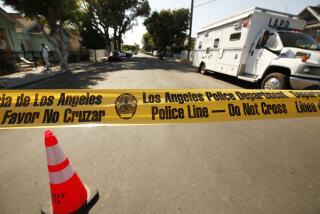Sheriff Weighs Deployment of Bomb Squad
Responding to criticism that it reacted too slowly to an April 20 bomb scare at Burbank Airport, the Sheriff’s Department released a report this week saying that it would consider moving a bomb squad truck to northern Los Angeles County.
But some security experts said the report failed to address broader policy issues, including authorities’ reaction time and internal communication, despite the department’s contention that the team’s actions were a textbook response to the incident.
“Yes, you can say they went by the book, but going by the book doesn’t guarantee things don’t go wrong,” said Brian Jenkins, a terrorism expert and a former member of the White House commission on aviation safety and security.
“The problem here remains the inordinate length of time it took to accomplish their [response] procedures,” Jenkins said.
David Latin, director of operations for the Los Angeles office of the Control Risk Group, said his concern was not so much the response time as how the incident was communicated to the public and the airlines.
“Ultimately, what they had was not a threat problem but a communications problem,” Latin said. “That’s assuming they neutralized the threat early on.”
The bomb scare shut down part of Burbank Airport for six hours and delayed thousands of air travelers after security officials detained a passenger carrying unidentified vials of liquid and a laptop computer.
A Times review found a number of problems with the response. In May, the county Board of Supervisors ordered a report detailing the sheriff’s response.
The sheriff’s report said the delay was caused not only by concern about a potential bomb in Ravi Desai’s luggage, but by Desai’s inability to communicate. He was, according to the report, “under the influence of alcohol and somewhat evasive as to the contents of his luggage.”
The carry-on bag contained a laptop computer, shaving kit, cellular phone, a half-quart of liquid in an opened water bottle, half a fifth of liquid in an opened vodka bottle and a date book, the report said.
But that was not the only problem, according to initial accounts of the bomb scare.
Airport authorities evacuated and closed Terminal A, home to Southwest and America West gates. Yet throughout the evening, they allowed planes to taxi up to some of the terminal gates.
The first announcement of a security risk was not made over the airport’s public address system until four hours after the emergency began about 4 p.m.
What’s more, the airport summoned the sheriff’s bomb team from Whittier, 31 miles away, instead of the one from the Los Angeles Police Department, which was nine miles away. The airport has no mutual aid agreement with the LAPD.
The squad, which had to fight through rush-hour traffic on a rainy Friday, did not arrive in Burbank until an hour and 20 minutes after the incident began.
Capt. Jerry Barnes of the sheriff’s arson explosives unit, said the proposal to locate a bomb squad truck in northern Los Angeles County was not a direct result of the Burbank bomb scare, but that it could help get teams there quicker in case of emergency.
They did not specify in what city the additional truck would be located.
Sheriff’s officials said they also discussed ways to minimize disruptions at the airport in the event of bomb threats and a possible mutual aid agreement between the department and the airport.
The airport now goes through the Burbank Police Department to request the sheriff’s help.
There also have been discussions with the LAPD about its possible involvement when the Sheriff’s Department can’t respond.
Whoever responds needs to follow the same careful procedures, Jenkins said. “The lesson learned here is that they have to do it faster,” he said.
*
Times staff writer Carol Chambers contributed to this story.
More to Read
Sign up for Essential California
The most important California stories and recommendations in your inbox every morning.
You may occasionally receive promotional content from the Los Angeles Times.










